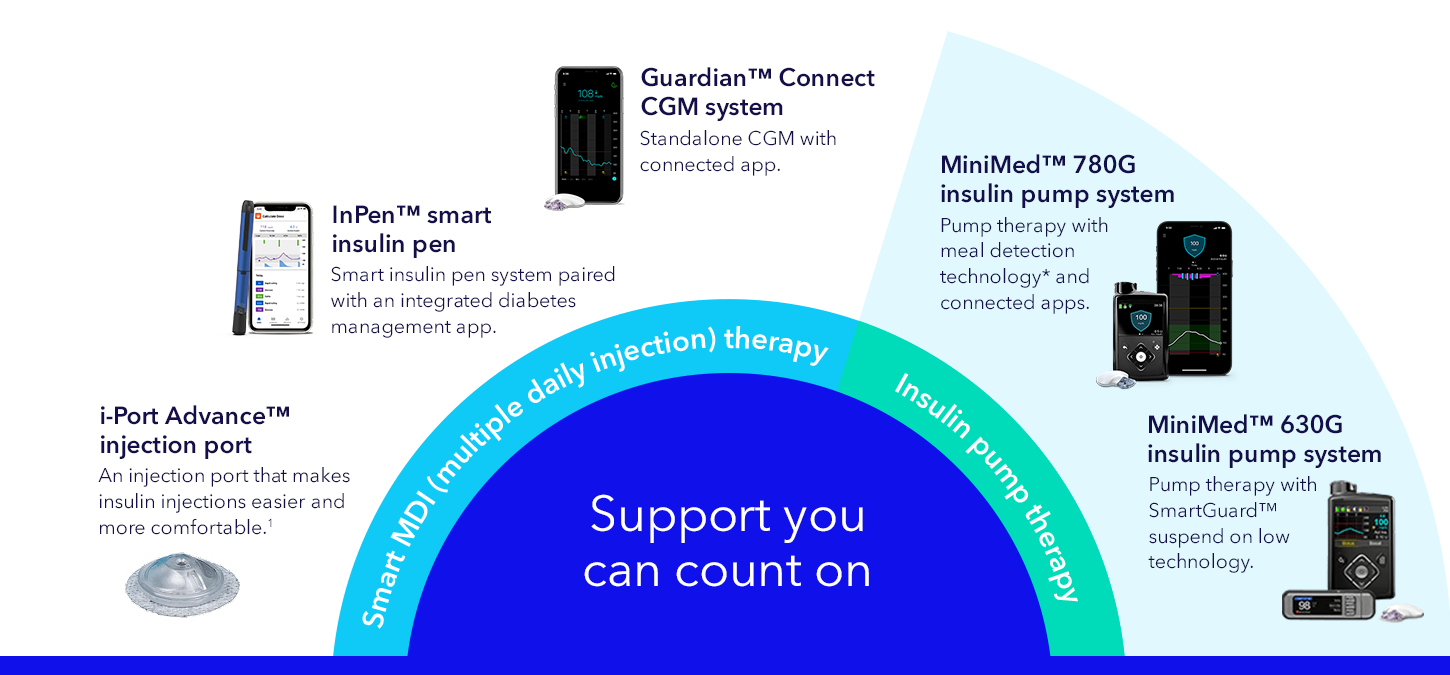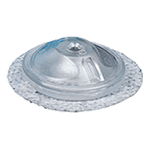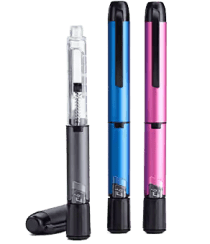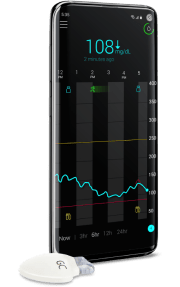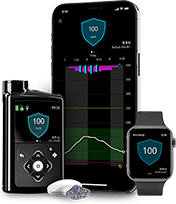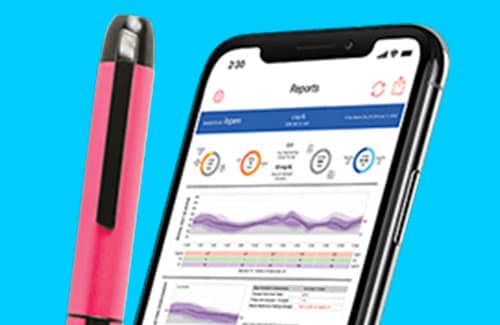People of Color have diabetes at higher rates,1 yet statistics show that:
more likely for Black or Hispanic Americans to die from diabetes-related complications.

more likely for Hispanic Americans to have diabetes-related amputations.

less likely for Black & Hispanic Americans to use a CGM.‡

less likely for Black Americans to use an insulin pump.2

A family of technologies
We develop technologies that allow you to focus more on life and less on diabetes.
View our portfolio of products designed to meet you wherever you may be in your diabetes journey (click on each image to view more).
Our access programs to help people start and stay on therapy
Support every step of the way
As your partner in care, we are here to help throughout your journey.
Help choosing the right therapy

Assistance
programs

Hands-on product
training

24-Hour technical
support

Online educational
resources

Clinical
support∆

Real customer care experiences

Join us in our commitment to bring technology education & awareness to all

* Refers to SmartGuard™ Auto Mode. Some user interaction required. Individual results may vary.
§ Smart insulin pens connect to a mobile app to provide dosing calculations, reminders and CGM system integration.
‡ Compared to White Americans
¶ MiniMed™ 770G System is for type 1 ages 2 and over. Prescription required.
† Smart CGM predicts future high and low sensor glucose events up to 60 minutes in advance.
†† Smart CGM predicts future high and low sensor glucose events up to 60 minutes in advance.
∆ Not intended to be a substitute for professional medical advice, diagnosis, or treatment. Always seek the advice of your physician or other qualified health provider with any questions you may have regarding a medical condition.
1. CDC. National Diabetes Statistics Report, 2020 pg. 4
2. Agarwal Et Al., Racial-ethic Inequality In Young Adults With Type 1 Diabetes. The Journal Of Clinical Endocrinology & Metabolism. Volume 105, Issue 8, August 2020, Pages E2960-e2969.
3. Riley D, Raup G. Impact of a subcutaneous injection device on improving patient care. Nurs Manage. 2010;41(6):49-54.
4. Injection port lets you take your medication without having to puncture your skin for each shot.
Important Safety Information: MiniMed™ 770G System With SmartGuard™ Technology
The MiniMed™ 770G system is intended for continuous delivery of basal insulin (at user selectable rates) and administration of insulin boluses (in user selectable amounts) for the management of type 1 diabetes mellitus in persons two years of age and older requiring insulin as well as for the continuous monitoring and trending of glucose levels in the fluid under the skin. The MiniMed™ 770G System includes SmartGuard™ technology, which can be programmed to automatically adjust delivery of basal insulin based on continuous glucose monitoring (CGM) sensor glucose values (SG) and can suspend delivery of insulin when the SG value falls below or is predicted to fall below predefined threshold values.
The Medtronic MiniMed™ 770G System consists of the following devices: MiniMed™ 770G Insulin Pump, the Guardian™ Link (3) Transmitter, the Guardian™ Sensor (3), one-press serter, the Accu-Chek® Guide Link blood glucose meter, and the AccuChek®Guide Test Strips. The system requires a prescription.
The Guardian™ Sensor (3) has not been evaluated and is not intended to be used directly for making therapy adjustments, but rather to provide an indication of when a fingerstick may be required. All therapy adjustments should be based on measurements obtained using a blood glucose meter and not on values provided by the Guardian™ Sensor (3).
All therapy adjustments should be based on measurements obtained using the Accu-Chek® Guide Link blood glucose meter and not on values provided by the Guardian™ Sensor (3). Always check the pump display to ensure the glucose result shown agrees with the glucose results shown on the Accu-Chek® Guide Link blood glucose meter. Do not calibrate your CGM device or calculate a bolus using a blood glucose meter result taken from an alternative site. It is not recommended to calibrate your CGM device when sensor or blood glucose values are changing rapidly, e.g., following a meal or physical exercise.
WARNING: Do not use the SmartGuard™ Auto Mode for people who require less than 8 units or more than 250 units of total daily insulin per day. A total daily dose of at least 8 units, but no more than 250 units, is required to operate in SmartGuard™ Auto Mode.
WARNING: Do not use the MiniMed™ 770G system until appropriate training has been received from a healthcare professional. Training is essential to ensure the safe use of the MiniMed™ 770G system.
Important Safety Information: MiniMed™ 630G System with SmartGuard™ Technology
Indicated for the continuous delivery of insulin, at set and variable rates, for the management of diabetes mellitus. MiniMed™ 630G system is approved for ages 14 years or older with Guardian™ Sensor 3 and MiniMed™ 630G system is approved for ages 16 years or older with Enlite™ sensor. Both systems require a prescription. Insulin infusion pumps and associated components of insulin infusion systems are limited to sale by or on the order of a physician and should only be used under the direction of a healthcare professional familiar with the risks of insulin pump therapy. Pump therapy is not recommended for people who are unwilling or unable to perform a minimum of four blood glucose tests per day. Pump therapy is not recommended for people who are unwilling or unable to maintain contact with their healthcare professional. Pump therapy is not recommended for people whose vision or hearing does not allow recognition of pump signals and alarms. Insulin pumps use rapid-acting insulin. If your insulin delivery is interrupted for any reason, you must be prepared to replace the missed insulin immediately. Replace the infusion set every 48–72 hours, or more frequently per your healthcare professional’s instructions. Insertion of a glucose sensor may cause bleeding or irritation at the insertion site. Consult a physician immediately if you experience significant pain or if you suspect that the site is infected. The information provided by CGM systems is intended to supplement, not replace, blood glucose information obtained using a blood glucose meter. A confirmatory fingerstick using a CONTOUR®NEXT LINK 2.4 meter is required prior to making adjustments to diabetes therapy. Always check the pump display when using a CONTOUR®NEXT LINK 2.4 meter, to ensure the glucose result shown agrees with the glucose results shown on the meter. Do not calibrate your CGM device or calculate a bolus using a result taken from an Alternative Site (palm) or a result from a control solution test. If a control solution test is out of range, please note that the result may be transmitted to your pump when in the “Always” send mode. It is not recommended to calibrate your CGM device when sensor or blood glucose values are changing rapidly, e.g., following a meal or physical exercise. The MiniMed™ 630G system is not intended to be used directly for preventing or treating hypoglycemia but to suspend insulin delivery when the user is unable to respond to the Suspend on low alarm and take measures to prevent or treat hypoglycemia themselves. Therapy to prevent or treat hypoglycemia should be administered according to the recommendations of the user’s healthcare provider.
WARNING: The SmartGuard™ Suspend on low feature will cause the pump to temporarily suspend insulin delivery for two hours when the sensor glucose reaches a set threshold. Under some conditions of use the pump can suspend again, resulting in very limited insulin delivery. Prolonged suspension can increase the risk of serious hyperglycemia, ketosis, and ketoacidosis. Before using the SmartGuard™ feature, it is important to read the SmartGuard™ feature information in the User Guide and discuss proper use of the feature with your healthcare provider.
Important Safety Information: Guardian™ Connect CGM System
The Guardian™ Connect system requires a prescription and is indicated for continuous or periodic monitoring of glucose levels in the interstitial fluid under the skin, in patients (14 to 75 years of age) with diabetes mellitus. The system is intended to complement, not replace, information obtained from standard blood glucose monitoring devices, and is not recommended for people who are unwilling or unable to perform a minimum of two meter blood glucose tests per day, or for people who are unable or unwilling to maintain contact with their healthcare professional. The system requires a functioning mobile electronic device with correct settings. If the mobile device is not set up or used correctly, you may not receive sensor glucose information or alerts. For complete details of the system and its components, including warnings, contraindications, and precautions, please consult the user guide at http://www.medtronicdiabetes.com/support/download-library/user-guides and important safety information.
The system is intended to complement, not replace, information obtained from standard blood glucose monitoring devices. All therapy adjustments should be based on measurements obtained from standard blood glucose monitoring devices and not on values provided by the system.
Important Safety Information: InPen™
The InPen™ is a home- use reusable pen injector for single- patient use by people with diabetes under the supervision of an adult caregiver, or by a patient age 7 and older for the self- injection of a desired dose of insulin and for calculating an insulin dose or carbohydrate intake based on user entered data. A healthcare professional must assist in dosage programming of the device prior to use, based on various patient- specific criteria and targets. The InPen™ requires a prescription. For additional product and safety information, please consult the Instructions for Use and bit.ly/InPenRisks.
Important Safety Information: i-Port Advance™ Injection Port
i-Port Advance™ injection port is indicated for patients who administer or receive multiple daily subcutaneous injections of physician prescribed medications, including insulin. The device may remain in place for up to 72 hours to accommodate multiple injections without the discomfort of additional needle sticks. i-Port Advance™ injection port may be used on a wide range of patients, including adults and children. Prescription required. For more, please see http://www.medtronicdiabetes.com/important-safety-information.

Roche and Roche logo are trademarks and/or registered trademarks of F. Hoffmann-La Roche Ltd.

